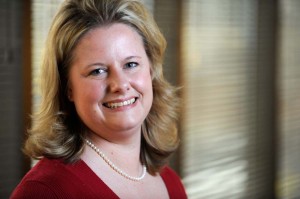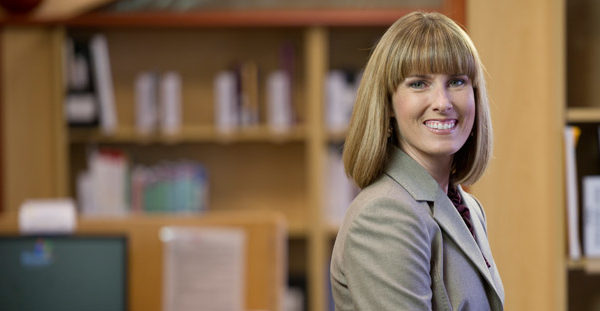Q and A
by Kathy Rivers
Tonia Moore-Davis, MSN, CNM, manages the VUSN nurse-midwifery practice at two sites in Nashville with a daily staff of 10 serving clients across a wide cultural, educational and socio-economic spectrum. The faculty practice serves as an incubator for nurse-midwifery students, consistently wins national awards, and delivered more than 1,000 babies last year. In June, Moore-Davis will step down from her full-time leadership role into a part-time practice position while she pursues her PhD. At that time, Sharon Holley, DNP, CNM, and Margaret Buxton, MSN, CNM, will assume permanent leadership positions at the Franklin Road and West End practices, respectively.
Why did the School of Nursing start a faculty practice?
VUSN wanted to create a site for students to have clinical placements and experience a true nurse-midwifery model of care. We started in Dickson with two nurse-midwives. We’ve grown over the years and 11 years ago moved onto campus. We have divided into two sites and take about eight students a semester for clinical rotations.
What is the scope of the current practice and how do the two sites work together?
Our clientele want an atmosphere where they are given information, helped and included in the decision-making process. Within our practice, we have commercially or privately insured clients who we see at our West End location. They are consumer-driven, choice-informed, well-educated and on the upper end of the socio-economic scale. At Franklin Road, we partner with a federally qualified community health center and serve a population of women on Medicaid as well as women who are uninsured or underinsured. There’s a true opportunity there to reach into those populations and empower those women by helping them become involved in their health care decision making.
What are the benefits to patients in a nurse-managed care model?
Most of the benefits are related to the holistic approach. Nurses, whatever their flavor of specialty, address patient needs, not only of the body and medical needs, but of what the patient defines as wellness.
I find that the nurse-midwifery model of care is really the hallmark of nurse-managed care because we meet the client wherever their definition of health and wellness is. We guide them along through their course of pregnancy, hopefully educating them as they go, and address not only the mother’s needs, but the family’s needs, the extended family’s needs and we’re also looking at spiritual, mental and soulful wellness. We look at social services, how mom is adjusting to pregnancy and lots of patient education that goes on. Our appointments are longer, anywhere from 20 to 40 minutes with a client, depending on the stage of the pregnancy.
Why do you think the practice has grown?
The market has demanded it. More consumers are looking for a style of care that they can get with nurse-midwives. Clientele are much more educated, and they want to help make their health care decisions. We really are the only game in town for women looking for private practice nurse-midwives.
Where do you see the practice heading?
I want to see this practice on the cutting edge of nurse-managed health care as well as nurse-midwife-led care. We work with Vanderbilt and the School of Medicine faculty so well and we are so well supported, that the sky is the limit. I would love to see a part of the mission include additional hospitals and birth center opportunities in town. The timing is right in the marketplace, and we can provide richer learning experiences for our students rather than having to send them hours away to get an out-of-hospital birth experience.
Do you have other visions?
We would love to have a boutique health care opportunity for the well-educated client who wants more than just prenatal care. We would like to build a network of resources for our moms so we can partner with community members to offer breastfeeding classes, massage therapy and prenatal yoga classes all on site. We want to make our practice a one-stop shop and fulfill the need in our community. The services we envision wouldn’t be just for our clients, we would open them up to the general public.
What opportunities or obstacles do you see with health care reform?
Right now we don’t foresee our practice being impacted too greatly by health care reform. There are a couple of things that have the potential to positively affect nurse-midwives. Reimbursement rates for nurse-midwives are now guaranteed at 100 percent reimbursement of the physician fee in Medicare, where we used to be at 85 percent. The hope is that other insurers will follow suit. The other piece we see coming is more emphasis on pay for performance, and that is where nurse-midwives will shine.
What obstacles have you had to growing the practice?
Our greatest issue is smart growth. We don’t hope to capture every pregnant woman in Nashville and become the baby mecca of the city. We want the clientele who are willing to change the way they seek their health care, or those who we think we can have a positive influence on. We will have about 1,000 births this year within the faculty practice, which is about one-third of VUMC’s volume. Both the Medical Center and our clinics are feeling the stretch in terms of managing our current volume. We want to grow along the lines of the School of Nursing’s education and community service mission rather than simply going after market share.
Any lessons learned in launching the Franklin Road clinic in 2010?
It was everything I expected and more in terms of stress as well as joy – to really build something from the ground up and think through the processes of the office and flow. To give a group of nurse-midwives the tools they need and see them run with them is amazing. I couldn’t have asked for a better group to lead the program there. The School of Nursing’s strategic partnership with University Community Health Services, a federal community health center organization, is the reason we were able to open this site. The Federally Qualified Health Center (FQHC) provided all of the funding required to renovate and equip this women’s health center site and it pays the salaries of our nurse- midwifery providers there. The resulting synergy fosters a unique and sustainable model for patient care, student training, and nurse-midwifery practice. As far as I know, this site and this women’s health faculty practice arrangement is one of a kind, nationally.
What is the preceptor experience like?
It includes nurse-midwifery students as well as nurse practitioner students and medical students. On any given day each student is assigned to a primary mentor or preceptor and they will work with that preceptor to decide what learning experiences they need. It could be seeing Obstetric patients in the clinic all day or assisting a nurse-midwife with hospital births. The unique piece for the nurse-midwifery students is their full-scope senior practicum. They are assigned to follow and live the life of a nurse-midwife for the semester – they do office work, hospital work and get a nice mix of both.
Are you seeing trends with new students?
We are seeing second-career students such as people with previous degrees and previous careers completely unrelated to health care. It’s really interesting to see the number of students who chose nurse-midwifery because they had their own birth experience with a nurse-midwife. Students have said: “I would never be in nursing, but I had my baby with a nurse-midwife (either by choice or default) and I was so moved by the experience, that I knew that’s what my life work should be.” Those are really powerful stories.
How does this practice compare nationally with others?
Among nurse-midwifery faculty practices, we are in the top 5 percent in volume. The American College of Nurse-Midwives (ACNM) considers us a large nurse-midwifery practice. Each year, we do well in sustaining a high-quality of care, and in 2010, ACNM recognized our practice as having the best rate of attempted vaginal birth after C-Section (VBAC) rates in the country. We are very proud of that.
Are there other practices that you use as a role model?
The University of Colorado-Denver Nurse-Midwifery service is structured very similarly to ours. Their practice director and I are good friends. And, we benchmark against each other, though Denver is a much more midwifery-friendly area than Nashville.
Why did you choose nurse-midwifery?
In my imagination, I was delivering babies when I was 5. There were no chalkboards at my house, there were fictitious babies coming out of bellies. After working as a labor and delivery nurse for six months, I realized that my way to impact women was in a provider role. The nurse model of care fit my personal philosophy more than the medical model.
How did you go from nurse-midwife to practice manager?
By happenstance. I came to Vanderbilt after working in a low-risk private practice in Kentucky. When I came to Vanderbilt, I worked in the resident clinic as part of the mission to build a faculty presence of nurse-midwives in VUMC’s Ob/Gyn Department. When vacancies occurred, I was able to join the VUSN faculty practice and was willing to step into a management role because I saw a lot of potential.
What do you want everyone reading this to know?
That we are viable, and we are here to stay. We have a strong foothold here and the leadership around the practice is committed. We are about training future nurse-midwives. Unfortunately, about 95 percent of our VUSN nurse-midwifery students have to leave Tennessee to get a job. We don’t want Tennessee to lose these capable nurse-midwifery graduates, so we want to be a role model to show others that there is growing consumer demand for nurse-midwives in our area. We want to expand nurse-midwifery options to other hospitals in Middle Tennessee so that more women can choose this option. We would also like to work toward a birth center option in this region.








